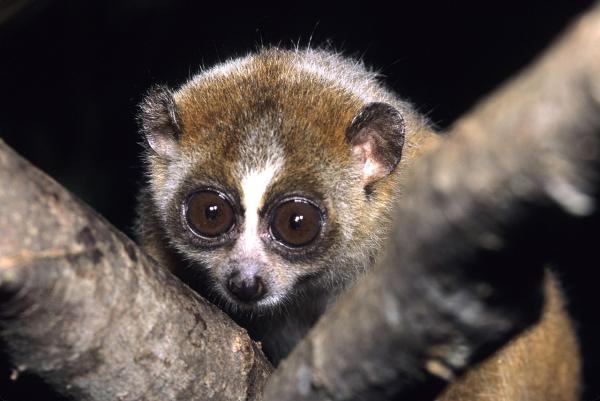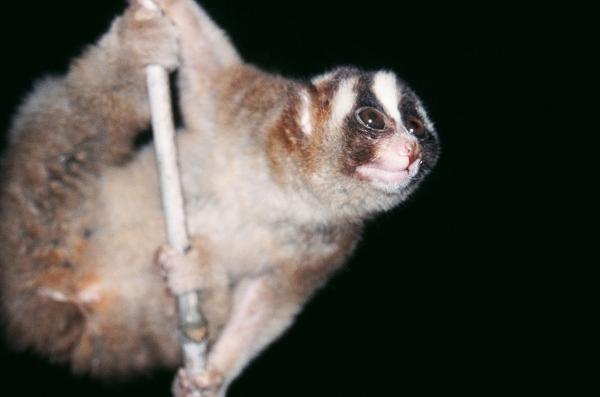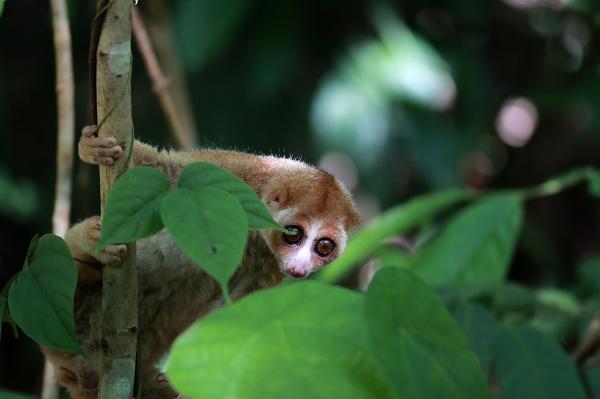When we think of primates, gorillas and chimpanzees usually come to mind. However, the primate family is much more diverse—and one of its lesser-known members, the slow loris, stands out for a very peculiar reason: it’s the only known venomous primate in the world.
Is the slow loris dangerous? Where does it live? What does it eat? In this article, we’ll explore the physical characteristics, habitat, diet, and reproductive behavior of the slow loris, along with its venomous defense mechanism and why it’s endangered.

Body Size: Slow lorises are small primates, measuring between 26 and 38 cm in length.
Head & Eyes: They have a round head, small ears, and large forward-facing eyes, adapted for night vision. Their eyes are surrounded by dark rings, giving them an adorable—but deceptive—look.
Fur: Their dense coat ranges from white to brown, and coloration can vary between individuals.
Limbs: They have equal-length forelimbs and hindlimbs, with opposable thumbs for gripping branches. Unlike monkeys, they cannot jump but climb slowly and carefully through trees.
Tail: Short and barely visible.
Nocturnal: Slow lorises are night-active creatures with exceptional low-light vision, thanks to a special reflective eye tissue called tapetum lucidum.
Arboreal: They spend their lives in trees and rarely descend to the ground.
Solitary & Stealthy: Timid and quiet, they lead solitary lives, only interacting during mating seasons.
Very Slow Movers: Their movements are so slow and deliberate that they're often mistaken for being lethargic.
The slow loris has a unique venom delivery system among mammals:
Venom Source: Not in their saliva—but in a gland on the inside of their elbows called the brachial gland.
Activation: They lick this gland, mixing the secretion with their saliva to make it venomous before biting.
Effects on Victims: The venom can be lethal to small animals and cause severe symptoms in humans.
If bitten by a venomous slow loris, symptoms can include:
Drop in blood pressure
Burning sensation in the mouth and throat
Involuntary muscle contractions
Breathing difficulties
Cardiac irregularities
Loss of consciousness
In rare cases, death from anaphylactic shock
Treatment: Seek immediate medical attention. Doctors typically administer tetanus shots, antibiotics, and monitor for allergic reactions.

Slow lorises are native to Southeast Asia’s tropical rainforests, primarily found in:
Vietnam
Indonesia
Malaysia
The Philippines
India
Bangladesh
They are strictly arboreal and require dense jungle canopies to survive. Deforestation and habitat loss have severely impacted their population.
Slow lorises eat both plant and animal matter:
Interestingly, they can consume some toxic plants that are harmful to humans.
Despite their diverse and nutritious diet, slow lorises have an unusually slow metabolism, similar to sloths. Scientists believe this helps them digest complex food items, including those containing toxins.
Males compete for females and may use their venom in fights.
Females signal readiness through vocalizations and urine marking.
Internal fertilization occurs in the trees, and males may deposit a copulatory plug to prevent other males from mating with the same female.
Polygamous: One female may mate with multiple males.
Multiple heat cycles: Females go into estrus several times a year, each lasting about 30 days.
Gestation period: Approximately 188 days.
Litter size: Typically one baby, though twins are possible.
Parental care: Females are highly protective and may use their venom defensively.
Weaning: Offspring are weaned between 3–6 months.
Sexual maturity: Reached at about 20 months.

Despite their cute appearance, slow lorises are wild animals and not suitable as pets. Here’s why:
Illegal Wildlife Trade: Many are captured from the wild, and their venom glands are cruelly removed—often improperly.
High Mortality: Captivity causes stress, reproductive issues, and early death.
Ethical Concerns: Keeping wild animals as pets fuels extinction by reducing wild populations and encouraging poaching.
Note: The slow loris has been listed as an endangered species since 2012 and is protected under international law.
The slow loris is one of nature’s most fascinating yet vulnerable creatures. With their wide eyes, stealthy movements, and venomous bite, they remind us how diverse and complex the primate world can be.
If you care about wildlife, say no to exotic pet ownership and help raise awareness of conservation efforts. Let these animals live safely in their natural rainforest homes.
Bibliography
Dodd, T., Ankel-Simons, F., Berkowitz, B., et al. (2018) Nycticebus- an overview. Available at: https://www.sciencedirect.com/topics/agricultural-and-biological-sciences/nycticebus
Peña, P. (2013) “Nycticebus coucang” Available at: https://animaldiversity.org/accounts/Nycticebus_coucang/
Beatty, R., Beer, A., & Deeming, C. (2010). The book of nature. Great Britain: Dorling Kindersley.
animal tags: slow loris
We created this article in conjunction with AI technology, then made sure it was fact-checked and edited by a Animals Top editor.